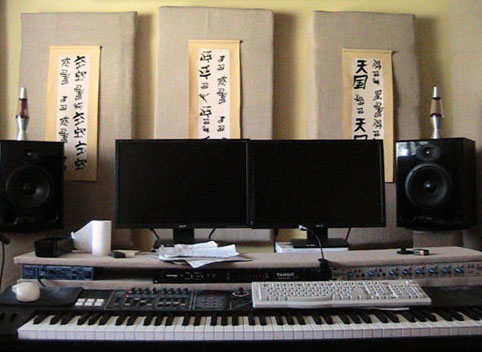STUDIO I: The Wiring
When I bought my house, I realized that there was no way I could afford to put in a proper studio ‘room within a room’ of proper size for really good acoustics right away. On a different track, my house has a crawlspace. When I went under the house to run a network cable between two rooms I decided, since I had to be down there anyway, to create structured cabling throughout the entire house so that every house could have Ethernet (I’d had very bad performance issues with WiFi.) Now after living there for a few weeks I realized that every room has it’s own unique sound and I decided that, since I already had cabling in place, I’d add audio and digital lines to each room. It turns out that it’s not that hard to expand lo-z audio, SP/DIF and lightpipe connections. This gave me the ability to use each room as either:
a) A place to record; each room having a ‘special sound’
b) The ability to put visiting musicians anywhere I needed for recording
c) The ability to put all the computers in and run computers out of sight and out of earshot.

STUDIO II: The Acoustics
I picked a particular bedroom to use as a control room and began fitting that with acoustic treatment. There’s a ton that needs to be learned about this stuff and I can recommend visiting the StudioTips Forum for all kinds of good advice. Like many people, my pimp became my local insulation contractor. I’ve made enough absorbers from Owens-Corning 703 to keep a whole village warm. I make many of these with wooden frames and move them about from room to room as needed. In addition to absorption, another thing I did which really helped was building proper speaker stands from concrete and spending a lot of time positioning them properly.
And speaking of ‘positioning’, if one wanted to improve one’s room, the first thing to do is to analyze the room and this alone is worthy of many pages. In fact, I’d suggest that proper positioning is at least as important as any ‘treatment’ one may attempt–especially in a small room. One’s best strategy may in fact be to simply find the best possible listening position and call it a day. One learns after much effort that there is only so much one can do beyond the basic laws of physics. A room needs to be a certain size and have certain attributes in order to be reliable.
STUDIO III: The Recording Gear
I’ve discussed the ‘real’ instruments I play here. The recording end of it currently consists of 2 main computers running Steinberg NUENDO and Cubase with VSTLink and Magix Samplitude. I’m listing the junk below more as a way for me to remember to come back here and start fleshing out various things I want to say about each tool.
A/D-D/A
- RME 9652
- Frontier Designs Tango/24
- Presonus Digimax
- Samson Control-C monitor/headphone mixer
TRANSDUCERS
- Event ASP-8 Monitors
- Cambridge ‘PC Works’ computer speakers w subwoofer.
- Beyerdynamic DT770 headphones
- Sony 7560 headphones
- Sony walkman headphones
Mics:
- Apex 460 tube (w Oktava mod)
- Studio Projects C1
- Blue Reactor
- Shure SM57
- Electro Voice RE-20
- Earthworks SR77
- Behringer EMC8000
- Crown PZM (2)
These all run direct through to the Digimax or through a home-made mic pre I’ve done which is basically a Neve 1073-style clone.
Controllers:
- CME UF8 Keyboard
- Alternate Mode Drum Kat (2)
- 3 Yamaha MIDI foot pedals
External Gizmos
- Numark TT200 turntables (2)
- Numark DM1000 DJ mixer
Pedals
- Volume
- Boss CE2 chorus
- Boss OC-1 octave pedal
- Boss Super Distortion & Feedbacker
- Danelectro Free Speech talkbox
Amplifiers
- Mesa Boogie Studio .22
- Hartke 3500 tube/transistor bass head
- Polytone 100
STUDIO IV: Software
Sampling
Pretty much everything is done through NI’s Kontakt 3 now. I originally developed libraries and some add-on plug-ins for Steinberg’s Halion, but that’s pretty much a dead end now. These are the commercial libs I have used a lot and can highly recommend.
- Vienna Symphonic Library
- BelaDMedia Anthology Winds
- EastWest Quantum Leap Orchestra & Symphonic Choirs
- Chinee Kong ‘China’
- Flying Hand Ethnic Percussion
- KickAss Brass
- Sample Tekk Black Grand
- Scarbee Imperial Drums, Clavinet, Fender Rhodes, Wurlitzer
- Tonehammer Percussion libraries
- Toontrack Superior Drummer
- Home Made:
- Prepared Piano (including bashing with sledgehammer)
- Bamboo Drums
- Washing Machine Drums
- Toolshop Percussion
- Bamboo Whistles
- Electrical Signals
Synths
These are especially near and dear to my heart, having started with my first synthesisers (a Moog Satellite and an Octave ‘Kat’) at the age of sixteen. I spend a lot of time tweaking and I’m never bored with it simply because I remember how excruciating it could be with patch cords or DX-7 algorithms where all could be lost with one mistake. Maybe that’s why I never really got into the ‘hardware v. software wars’. The advantages of save/recall are so amazing that they dwarf any sonic differences.
- Native Instruments Komplete
- Spectrasonics Omnisphere
- Ivory American Steinway
- GMedia’s MTron, Imposcar
- Arturia’s Jupiter 8v, CS-80v, Minimoog V












